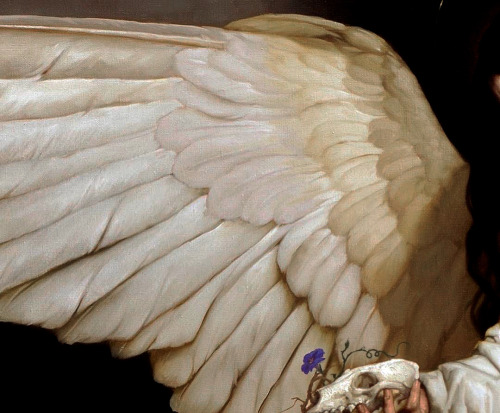Leafyfern - Flora And Fauna

More Posts from Leafyfern and Others
what's your opinion on handling tarantulas?
Oh man, you’re gonna make me open this can of worms?
It depends.
For Old World species (or Psalmopoeus or Tapinauchenius species) the answer is no, no, no, absolutely not, why would you even want to do that? That’s a great way to needlessly land yourself in a lot of pain (or the hospital) and the hobby in a lot of legal trouble. For quick, flighty, jumping-prone species (probably most arboreals) the answer is also mostly no, simply because you could so easily drop or lose your tarantula.
If you want to even consider handling your tarantula get a species that is good for handling (a slow, calm, terrestrial New World species). Even then you should take precautions, such as carefully observing the tarantula’s mood, gradually getting it used to handling/human contact, not handling too often, and only holding it over a solid surface.
Now, there are people that think even this kind of handling is needlessly risky and without benefits. Those people are absolutely welcome to their opinion (I think this is a decision each keeper must make for themselves), but I would like to address some misinformation that often gets thrown around in this debate.
1) “Tarantulas cannot learn or become accustomed to handling”
As someone with a degree in both psychology and biology this is simply not true. Pretty much any organism that is capable of registering pleasant/unpleasant stimuli and remembering it can learn. There are even studies suggesting that plants can remember and become desensitized to recurring stimuli. Scientists repeated the famous “Pavlov’s dog” experiment with cockroaches and the results were pretty much identical. Although they have very different nervous systems from ours invertebrates can absolutely learn.
Firing up the body’s flight/flight systems takes a lot of energy so if something frightening occurs repeatedly without anything actually bad happening it is in an organism’s best interest to stop reacting fearfully to that stimulus (or at least to dampen the reaction).
When socializing future education tarantulas I’ve watched them go from standing on as few legs as possible the first time they walk on your hand (what I call “tiptoes”) because they don’t like the texture of human skin to crawling over a hand as if it were just another familiar part of their environment. Some tarantulas also seem to show a marked preference for familiar human hands over unfamiliar ones; it’s been proven that hissing roaches can recognize individual humans and will not hiss when someone familiar picks them up (I would love to see a study like this done with tarantulas).
2) “A tarantula always perceives being picked up the same way it perceives being attacked/grabbed by a predator”
If you handle your tarantula correctly (using what I call the “be the ground” technique) then picking it up should not resemble a predator’s attack. There is no tarantula predator on earth that gently scoops the spider up from below. Spiders hate being breathed on and generally dislike being grabbed from above because those stimuli resemble something they would experience when being attacked by a predator (and so trigger their fight/flight alarm systems very strongly).
However scooping from below does not resemble a predator attack (assuming you’re not looming over the tarantula and breathing on them) and once they are in your hands most tarantulas will treat the hand as an inanimate surface not as a predator or even part of a larger animal. They don’t really have the senses or cognitive abilities to think “a giant animal is holding me”. More like “the ground moved and now I am standing on a weird new surface in a different place”.
The reality is that the handling of appropriate species is an enormously useful tool in educating people about tarantulas and dispelling fear. Can you educate people about tarantulas without handling them? Yes. But as someone whose full time job is to care for and educate people about arthropods I can tell you with 100% certainty that it does not have even close to the same effect.
Where I work we have dozens of beautiful, naturalistic enclosures displaying gorgeous rare tarantulas from all over the world. But the thing that gets people excited, wide-eyed, and asking questions is the highly-trained docent handling one of our well-socialized education tarantulas. There is something about seeing a person interact with the tarantula outside of a cage that makes it real for people. They ooh and aww and adults that were shrieking about how much they hate spiders while walking through the facility will say things like “I never realized how pretty they are up close” or “her feet look so dainty and gentle”.
So, while I respect every keeper’s right to decide what their comfort level and policies are when managing their own animals, I work at a facility where we handle some calm, well-socialized tarantulas and I (gently, occasionally, and with lots of precautions) handle one of mine. But it is certainly not something that people should do willy-nilly with any tarantula and without putting a lot of thought into doing it properly.
No one:
Bisexuals:







Not only are these pea-sized treehoppers amazing to look at - they sound like tiny dinosaurs. Scientists have studied their calls by pressing phonograph needles to the leaf stems where the treehoppers are often found. They send chattering, moaning calls through the plant to attract mates and warn other treehoppers about predators. I listened to those noises here and they are INCREDIBLE.
The treehoppers shown here are all members of the true bug family Membracidae. Image credits:
Thorn Mimic Treehopper by Yogendra Joshi Treehopper by H. K. Tang Alchisme grossa courtesy of Robert Oelman Ant-mimicking treehopper (Cyphonia clavata) by Andreas Kay Oak Treehopper (Platycostis vittata) by Matthew Cicanese Oak treehoppers with nymph by Ken-ichi Ueda


I hate that I’m always trying to find cool biology themed stuff to wear but all the “nature inspired” clothing companies just have like two crossed arrows or a minimalistic mountain on a sweatshirt. Fucking lame, that’s barely even nature-adjacent. Put the life cycle of a salamander on a jacket, put hyena skeleton patterns on leggings, put a damn field guide of birds of prey on a peacoat and THEN you can have my money. Do NOT give me a shirt with a leaf on it that says “stay wild” or some bullshit I would much prefer clothing that broadcasts to everyone around me how many teeth an adult Jaguar has or how some pitcher plants can catch and digest rats.
💚 Tumblr!!! You’ve been so kind to me! 💚
I’ve got 10 days left to raise funds for
DRYP - an app that helps you keep plants alive & happy!
This is a little ad I made for the app
out of frustration with the marketing of plants as lifestyle products for rich people with all-white apartments.
YOU TOO CAN HAVE A LOVELY GREEN HOME, I PROMISE! 💚🌱 IT’S NOT JUST FOR GWYNETH PALTROW!

Here again are the basic functions of the app:


And here again are some of the rewards for backing it!

Please signal boost to help me make this app a reality! Thank you! 🌱🌱🌱

hand over the cursed Sphenodon facts.
sure, but PUT THE GUN DOWN.
the Tuatara is a medium-sized reptile native to New Zealand.

it looks like a lizard but it IS NOT- the Tuatara is actually a very basal reptile related to snakes and lizards but belonging to an entire different branch of the tree of life, of which it is the sole surviving member.

and it may look like a lizard on the outside, but the inside is what really counts! and on the inside, the Tuatara is basically a reskinned amphibian.

they only have a single lung, their heart is the most basic of all reptiles, and their nervous systems shares more in common with our friend the axolotl than with its lizard kin!

so if you happen to see one at the zoo, take a moment to stop and really appreciate the uninterrupted 240 million years of reptilian history you’re lucky enough to be looking at!
One of these things is not like the others!
This handsome skull belongs to an iguana.


These all belong to water monitors.





And this one belongs to a tegu.


The tegu’s skull is missing a hole!
Those little openings on the top of the monitors’ heads and the iguana’s is where the pineal eye is located. The pineal eye can distinguish between light and dark, and helps with thermoregulation. But tegus don’t have it! They lost their pineal eye sometime during the course of their evolution- which is evidence of how even though they might look a bit like monitors, they really aren’t that closely related!








L'ala nera o Il tocco dell'angelo by Roberto Ferri
-
 greekedtext liked this · 1 week ago
greekedtext liked this · 1 week ago -
 juhaku-inspired reblogged this · 1 week ago
juhaku-inspired reblogged this · 1 week ago -
 siegecraft reblogged this · 1 week ago
siegecraft reblogged this · 1 week ago -
 holliday-inn liked this · 1 week ago
holliday-inn liked this · 1 week ago -
 link1sk liked this · 1 week ago
link1sk liked this · 1 week ago -
 figuerockfaeth liked this · 1 week ago
figuerockfaeth liked this · 1 week ago -
 aliceswonderblog reblogged this · 1 week ago
aliceswonderblog reblogged this · 1 week ago -
 forestfaggotree liked this · 1 week ago
forestfaggotree liked this · 1 week ago -
 manqoz reblogged this · 1 week ago
manqoz reblogged this · 1 week ago -
 linhuine liked this · 1 week ago
linhuine liked this · 1 week ago -
 notoriousmks liked this · 1 week ago
notoriousmks liked this · 1 week ago -
 pandabearry reblogged this · 2 weeks ago
pandabearry reblogged this · 2 weeks ago -
 nanoko857 liked this · 2 weeks ago
nanoko857 liked this · 2 weeks ago -
 prismaticowl reblogged this · 2 weeks ago
prismaticowl reblogged this · 2 weeks ago -
 vulvic liked this · 2 weeks ago
vulvic liked this · 2 weeks ago -
 bonelessbabe reblogged this · 2 weeks ago
bonelessbabe reblogged this · 2 weeks ago -
 icedragon19 liked this · 2 weeks ago
icedragon19 liked this · 2 weeks ago -
 sege-herbst liked this · 2 weeks ago
sege-herbst liked this · 2 weeks ago -
 reynainthef liked this · 2 weeks ago
reynainthef liked this · 2 weeks ago -
 yiilinglaozu liked this · 2 weeks ago
yiilinglaozu liked this · 2 weeks ago -
 whodaresdomore liked this · 2 weeks ago
whodaresdomore liked this · 2 weeks ago -
 friendlylocalgeek liked this · 2 weeks ago
friendlylocalgeek liked this · 2 weeks ago -
 aeternatv reblogged this · 2 weeks ago
aeternatv reblogged this · 2 weeks ago -
 griseldagimpel reblogged this · 2 weeks ago
griseldagimpel reblogged this · 2 weeks ago -
 gideonnavsenormousbiceps liked this · 2 weeks ago
gideonnavsenormousbiceps liked this · 2 weeks ago -
 deepthoughtswithmi liked this · 2 weeks ago
deepthoughtswithmi liked this · 2 weeks ago -
 autumnbasil liked this · 2 weeks ago
autumnbasil liked this · 2 weeks ago -
 sylvercat liked this · 2 weeks ago
sylvercat liked this · 2 weeks ago -
 memyselfiamweird liked this · 2 weeks ago
memyselfiamweird liked this · 2 weeks ago -
 mauvv-is-dead reblogged this · 2 weeks ago
mauvv-is-dead reblogged this · 2 weeks ago -
 ableedingpromise liked this · 2 weeks ago
ableedingpromise liked this · 2 weeks ago -
 cinnamonglaive reblogged this · 2 weeks ago
cinnamonglaive reblogged this · 2 weeks ago -
 renjunbabygirl reblogged this · 2 weeks ago
renjunbabygirl reblogged this · 2 weeks ago -
 onpaperpinions liked this · 2 weeks ago
onpaperpinions liked this · 2 weeks ago -
 maybeillwritesmth reblogged this · 2 weeks ago
maybeillwritesmth reblogged this · 2 weeks ago -
 maybeillwritesmth liked this · 2 weeks ago
maybeillwritesmth liked this · 2 weeks ago -
 ivehadenoughbitch reblogged this · 2 weeks ago
ivehadenoughbitch reblogged this · 2 weeks ago -
 coolspork liked this · 2 weeks ago
coolspork liked this · 2 weeks ago -
 mud-in-the-morning liked this · 2 weeks ago
mud-in-the-morning liked this · 2 weeks ago -
 cinnamonglaive liked this · 2 weeks ago
cinnamonglaive liked this · 2 weeks ago -
 wishes-and-stars reblogged this · 2 weeks ago
wishes-and-stars reblogged this · 2 weeks ago -
 wishes-and-stars liked this · 2 weeks ago
wishes-and-stars liked this · 2 weeks ago -
 onthestrangestsea liked this · 2 weeks ago
onthestrangestsea liked this · 2 weeks ago -
 moonstonemoonlight liked this · 2 weeks ago
moonstonemoonlight liked this · 2 weeks ago -
 geniusflesh reblogged this · 2 weeks ago
geniusflesh reblogged this · 2 weeks ago -
 brunetterightsactivist reblogged this · 2 weeks ago
brunetterightsactivist reblogged this · 2 weeks ago -
 eri-fuka reblogged this · 2 weeks ago
eri-fuka reblogged this · 2 weeks ago -
 half-eaten-piece-of-breaded-fish liked this · 2 weeks ago
half-eaten-piece-of-breaded-fish liked this · 2 weeks ago -
 unusualfaggot liked this · 2 weeks ago
unusualfaggot liked this · 2 weeks ago -
 jodie-whittakers-suspenders liked this · 2 weeks ago
jodie-whittakers-suspenders liked this · 2 weeks ago

skull and spider enthusiast//check out @voooorheestaurus sun moon & rising
201 posts